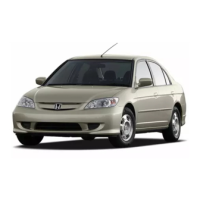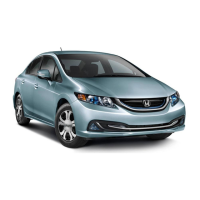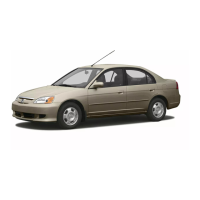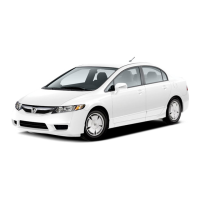
Do you have a question about the Honda Civic Hybrid and is the answer not in the manual?
| Brand | Honda |
|---|---|
| Model | Civic Hybrid |
| Category | Automobile |
| Language | English |
Precautions to take if the vehicle is damaged or collapsed during a crash.
Information on handling and proper disposal of the 158-volt Nickel-Metal Hydride battery.
Key safety recommendations for occupants and the vehicle.
Overview of features designed to protect occupants during a crash.
Information on the proper use and care of seat belts.
Explanation of how front, side, and curtain airbags function.
Instructions for proper positioning of driver, adults, and mature children.
General guidelines for restraining infants, small children, and larger children.
Guidance for safely restraining infants in rearward-facing systems.
Guidance for restraining children over one year old in forward-facing systems.
Criteria for choosing a child restraint system that meets safety standards.
Steps for correctly installing a child restraint system in the vehicle.
Guidance for children who have outgrown child restraints, focusing on seat belt fit.
Identifies controls and provides an overview of the instrument panel layout.
Explains the various indicator lights and gauges on the instrument panel.
Identifies controls located on or around the steering wheel for easy access.
Information on vehicle keys, lock types, and remote transmitters.
Explains the vehicle's anti-theft immobilizer system.
Details the four positions of the ignition switch and their functions.
Operation of door locks, power door locks, and lockout prevention.
Operation of the remote transmitter for locking, unlocking, and boot release.
Information on adjusting front and rear seats for comfort and safety.
How to apply and release the parking brake and interpret its indicator.
Overview of interior convenience features like glove box, console, and holders.
Operation of power windows, including auto and reverse functions.
Adjusting power mirrors and using the inside mirror's day/night feature.
How the automatic climate control system maintains interior temperature.
Overview of the vehicle's audio system types and operation.
How to use and operate the cruise control system.
Guidance on the initial break-in period and recommended fuel types.
Procedures for refueling the vehicle and operating service station equipment.
How to check the engine oil level and its importance.
Information on vehicle storage areas and proper luggage handling.
Guidelines on vehicle load limits to ensure safe operation.
Pre-drive checks and adjustments for vehicle safety.
Step-by-step instructions for starting the engine, including cold weather conditions.
Overview of the Continuously Variable Transmission and its operation.
Proper procedures and tips for parking the vehicle safely.
Details on the vehicle's braking system, including ABS and power assist.
Explains how ABS prevents wheel lock-up and maintains steering control.
How VSA helps stabilize the vehicle during cornering and slippery conditions.
Driving techniques and visibility considerations for rain, fog, and snow.
General safety precautions and requirements for performing maintenance.
Recommended maintenance intervals for keeping the vehicle in peak condition.
Items to check at specified intervals for vehicle upkeep.
How to check and add engine oil, including recommended types.
How to check and add engine coolant, with warnings about hot systems.
How to check and add transmission fluid for the CVT.
How to check brake fluid level and replace fluid.
How to clean and replace the air cleaner element.
Checking the operation of exterior lights and bulb replacement.
How to check the condition and replace wiper blades.
General information on tyre care, inflation, and inspection.
How to check the 12 volt battery condition and terminals.
Step-by-step instructions for removing and replacing the vehicle battery.
How to prepare the vehicle for extended storage.
Information on using the compact spare tyre as a temporary replacement.
Step-by-step instructions for changing a flat tyre safely.
Troubleshooting steps when the engine fails to start or stalls.
Procedure for safely jump-starting the vehicle's battery.
What to do if the engine overheats, including safety warnings.
Meaning of the red oil pressure indicator and immediate actions.
Meaning of the amber oil level indicator and checking engine oil.
What the charging system indicator signifies and troubleshooting.
Explains the malfunction indicator lamp and its relation to emissions systems.
Interpretation of the brake system indicator lights and related issues.
Location and checking of vehicle fuses.
Diagrams showing fuse box locations and protected circuits.
Instructions and precautions for emergency towing of the vehicle.
Locations of the vehicle's chassis, engine, transmission, and IMA motor numbers.
Technical specifications including dimensions, weights, and tyre information.
Information on the vehicle's emissions control systems.
How the catalytic converter works and its maintenance.












